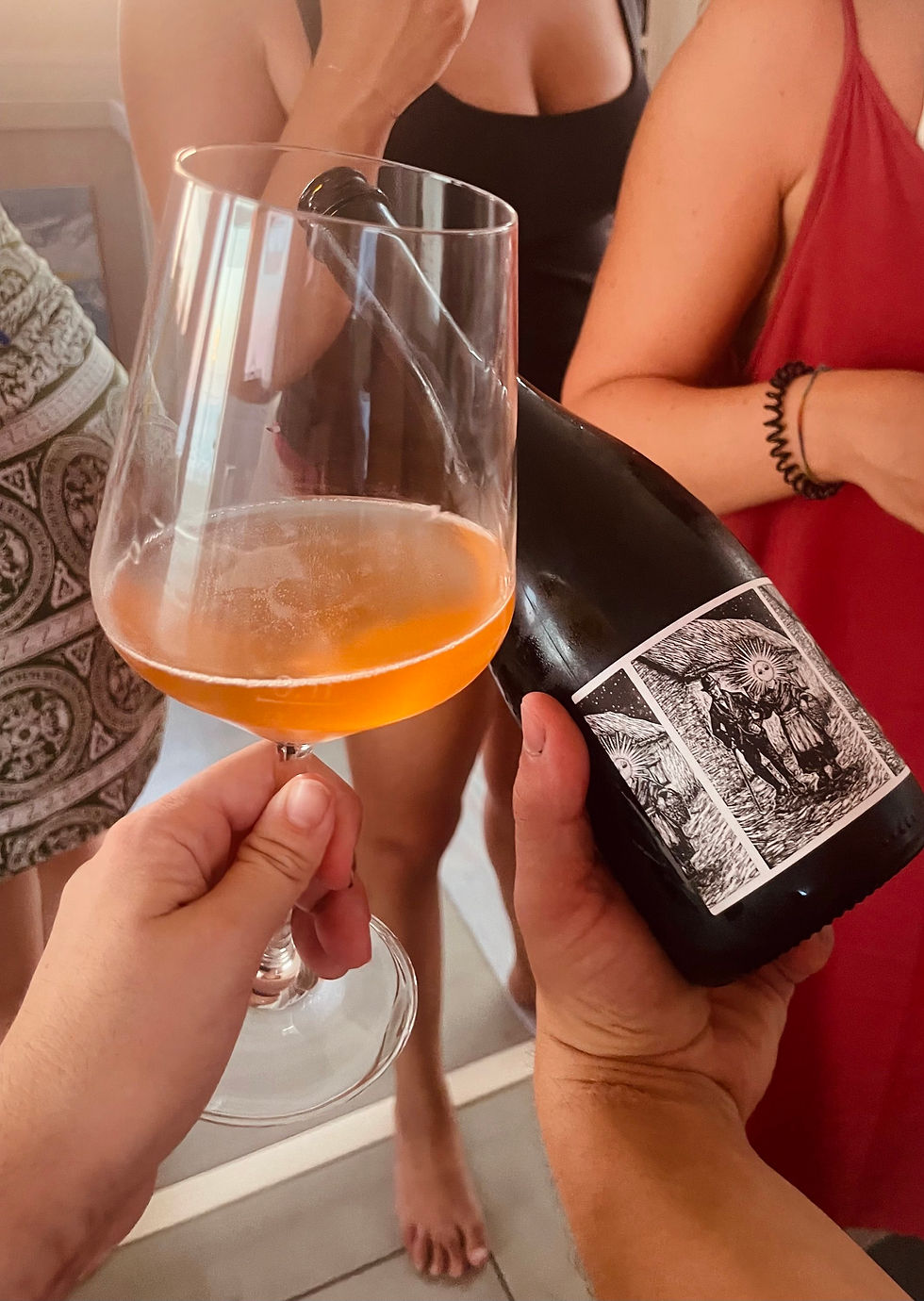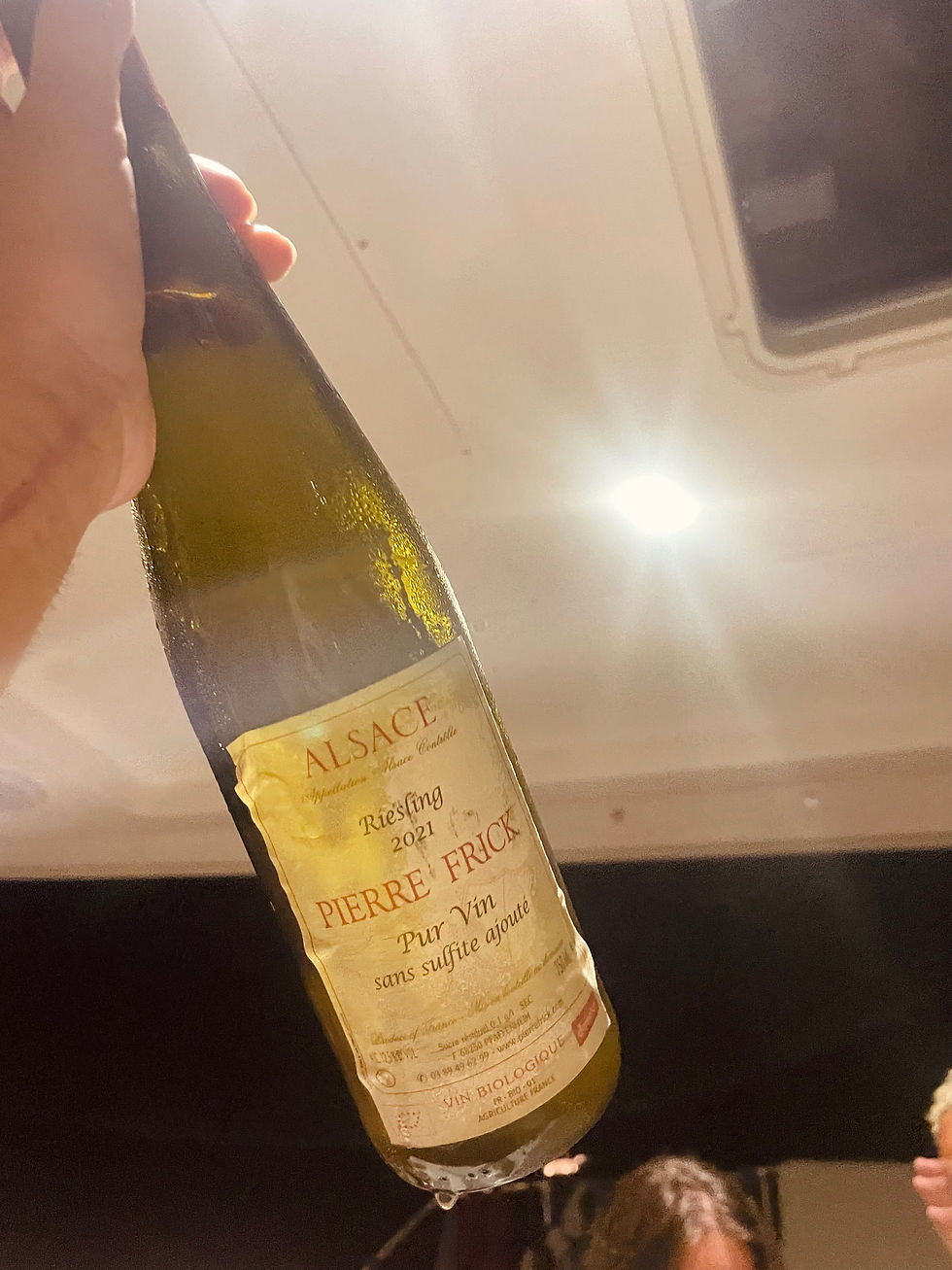
Sailing and Sipping: exploring wine highlights from a marine escape
- Alice Vanni
- Sep 18, 2024
- 5 min read

I was recently spoiled by friends with an exquisite selection of wines during a sailing trip through the stunning Tyrrhenian islands. Each bottle opened during our journey brought its own story of terroir, craftsmanship, and unique flavours, perfectly enhancing our travels from Corsica to Capraia Island and Elba Island. Below are the highlights of the trip, detailing the exceptional wines that accompanied us.
Trebbiano by Ausonia

The Trebbiano d'Abruzzo by Cantina Ausonia was the perfect start to our wine journey. Hailing from the foothills of the Gran Sasso in the Abruzzo region, Ausonia's vineyards are rooted in limestone and clay soils, which contribute to the mineral complexity of their wines. The winery is fully organic and biodynamic, committed to preserving the land's natural characteristics. The Trebbiano is known for its vibrant citrus notes, hints of green apple, and crisp acidity, making it an ideal pairing for seafood. I can still feel its freshness and zesty finish, which, in our case, made it an invigorating companion to the salty breeze of the Mediterranean.
The wine is deeply influenced by the microclimate of the Abruzzo region, with vineyards situated 270 metres above sea level, facing the Adriatic Sea. The cool mountain air and coastal influences combine to give the wine its fresh, clean profile.
Rosé from Syrah by Stefano Amerighi

Next up was a Rosé Syrah by Stefano Amerighi, a winemaker from the hills of Cortona in Tuscany. Amerighi is renowned for his dedication to biodynamic practices, and his rosé—made from 100% Syrah grapes—reflects this natural approach. Fermented spontaneously with native yeasts, the wine has notes of wild strawberries, herbs. The texture is lush but fresh, with bright acidity.
Amerighi's vineyards are located in the Val di Chiana, where clay and limestone soils are perfect for Syrah. The hot Tuscan sun during the day, coupled with cooler evenings, allows for optimal ripening of the grapes, resulting in a wine with depth and vibrant fruit flavours.
Trebbien by Mattoni

From the Marche region, Mattoni's Trebbien is a standout example of Trebbiano, one of Italy’s most widespread white grape varieties. This small, family-run winery is located in the hills near Ascoli Piceno, and the wine is made with an artisanal approach, focusing on sustainability and tradition. Trebbien offers a more complex and full-bodied take on Trebbiano, with aromas of ripe pear, almond, and honey, balanced by its fresh acidity.
Mattoni's vineyards sit at 200 metres above sea level, benefiting from a unique microclimate influenced by the Adriatic Sea. The calcareous clay soils add a certain richness and minerality to the wine, making Trebbien an excellent expression of its region.
Lambrusco di Sorbara by Bergianti – The best summer evergreen

A summer sailing trip wouldn’t be complete without a Lambrusco di Sorbara by Bergianti, a sparkling wine that has long been a favourite for its bright, effervescent qualities which looks like a rosé because of Sorbara grapes characteristics. Luciano Bergianti is a producer from Modena in Emilia-Romagna, specialising in organic and biodynamic farming. His Lambrusco di Sorbara is a light, dry version of the wine, bursting with red berries, violets, and a signature lively acidity. It's crisp, refreshing, and pairs perfectly with both casual picnic fare and more refined dishes. This particular bottle was a delightful refresher during warm afternoons on deck.
The vineyards are situated in the fertile plains of Modena, where the sandy and silt-rich soils encourage light, fragrant expressions of the Sorbara variety. The warm days and cool nights contribute to the wine's balanced structure.
Alsace Riesling by Pierre Frick

A shift in style brought us to the aromatic and complex Riesling by Pierre Frick from Alsace, France. Jean-Pierre Frick is a pioneer of biodynamic winemaking in the region, and his Riesling showcases the intense minerality of Alsatian terroir. With notes of citrus, white flowers, and a characteristic petrol undertone, this wine has both depth and elegance. Its zesty acidity and mineral backbone make it ideal for pairing with seafood, and it was an exceptional match for the freshly caught fish we enjoyed onboard.
Frick’s vineyards are located in the heart of Alsace, where the varied soils (from limestone to granite) and the dry, sunny climate create the ideal conditions for Riesling. The natural winemaking process highlights the purity of the terroir, resulting in a wine with a true sense of place.
Albamar by Bodegas Albamar – The Best Discovery

The Albamar Albariño by Bodegas Albamar was, without a doubt, the most exciting discovery of the trip. This Albariño from the Rías Baixas region of Galicia, Spain, is a fascinating wine, offering a perfect blend of salinity and fruit. The wine is aged in both barrel and steel for 8 months, which lends its complexity while preserving the crisp freshness of the grape. Its notes remind of flavours of green apple, citrus, and white peach, with a briny finish that feels tailor-made for a day at sea.
One of the most intriguing aspects of Albamar's vineyards is their proximity to the Atlantic Ocean. During high tide, the vineyards are occasionally submerged, and the influence of the ocean is clearly reflected in the wine's saline and mineral-driven character. The granitic soils further enhance the wine’s crispness and minerality, making it a perfect companion for sailing.
Mediterranean Stops: Corsica, Capraia, and Elba Island, some curiosities about its wine regions
Our wine journey started in Plage de Lotu, Corsica, known for its white sandy beaches and turquoise waters. The rugged beauty of Corsica, with its mountainous terrain and wild coastline, provides the perfect backdrop for local wines like Patrimonio and Ajaccio, made from indigenous grapes like Nielluccio and Vermentino.
From Corsica, we sailed to Capraia Island, one of the Tuscan Archipelago islands, which boasts pristine landscapes, rugged cliffs, and crystal-clear waters. The island’s Mediterranean flora adds a wild charm, and while the vineyards here are sparse, the local cuisine—featuring fresh fish, olive oil, and herbs—is a celebration of simplicity and flavour.
Our final stop was Elba Island, famed for its connection to Napoleon history and its excellent wines. The island’s wines, particularly the sweet Aleatico dell'Elba, are a must-try. Elba’s picturesque vineyards, set against rolling hills and surrounded by the Tyrrhenian Sea, produce a wide range of wines, from fresh whites to robust reds.
This sailing trip was a reminder of how intertwined wine, terroir, and experience are. Each bottle opened brought a sense of place to our journey, and the wines we enjoyed enhanced the beauty of our surroundings. From the saline kiss of the Albariño to the refreshing pop of Lambrusco, every glass was a celebration of the regions we traversed.
I’m already dreaming about the next sailing adventure and the wines that will accompany us. Until the next "sailing wines" episode!
#sailing #summer #estateitaliana #vitalenta #naturalwines #wines #winelovers #winegeek #italy #sailingwines #tuscany #winenot #petnat #lasobria











Comments